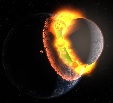|
Your Science Theories
|
|
| Hornblower | Date: Tuesday, 04.10.2016, 00:35 | Message # 1 |
 World Builder
Group: Users
 United States
United States
Messages: 714
Status: Offline
| I don't think there's a thread for this, so here you go. I'll start it off with something I've been pondering. What if the 4th spatial dimension and time are the same thing. In other words, from a 4D (spatial) perspective, the entirety of time is visible. Not only that, but the universe's expansion causes the illusion of time. It's like we are expanding through 4D space and into the next frame of time. In other words, the "balloon" idea where the universe's center is not in our space can be taken almost literally. The universe is like a 4D balloon with a 3D membrane that stretches through 4D space and into the next frame of time. In other words, the arrow of time is outward in the 4th dimension. This would look amazing from the Fourth Dimension; the complete structure of all space and time. However, one would have to observe it from 5D space to really appreciate it. 5D space, as far as this theory goes, is unrelated to time and only to Euclidean space. Every frame of the universe would be completely visible. However, the "many worlds" interpretation of quantum mechanics states that there are an infinite number of possibilities. From a 4D perspective, only one slice or possibility is visible. From 5D, all the possibilities are visible. This is what I would call the "multiverse." Again, to truly admire it, you must view the multiverse from the 6th spatial dimension. If you are reading this sentence, congratulations! You are listening to my theory! Now, in 6 spatial dimensions, there might be multiple multiverses. Different big bangs which created an infinite amount of possibilities in that universe. This multiverse is just a frame of an infinite number of multiverses in the omniverse. The omniverse is everything ever. Also keep in mind that in the spatial dimensions above 3, time does not exist in the way we see it. To us time is like an animation. There is no animation in the 4th dimension; all of the frames of time are visible at once. Then all the possibilities of those frames can be viewed from the 5th dimension, and all the different universes are viewed in the 6th dimension. Here's a conundrum, in string theory, there are 10 universes and possibly an eleventh. The seventh dimension is being able to see everything and everything inside it at once, and the 8th dimension on wards might add nothing unless there are multiple omnivores and multiple multiple omniverses and so-on. What do you think?
Sorry for the long read and feel free to share your own theories
Edited by Hornblower - Tuesday, 04.10.2016, 00:36 |
| |
| |
| Banana | Date: Tuesday, 04.10.2016, 01:36 | Message # 2 |
 Astronaut
Group: Users
 United States
United States
Messages: 56
Status: Offline
| Wow! That's a very in-depth theory! Have you put any thought into what may divide separate multiverses or omniverses?
Hello.
|
| |
| |
| Hornblower | Date: Tuesday, 04.10.2016, 01:41 | Message # 3 |
 World Builder
Group: Users
 United States
United States
Messages: 714
Status: Offline
| Banana, well, that part of my theory is part of an existing theory, the many worlds interpretation of quantum physics. Basically, there aren't any changes on a macro-scale (our scale) that cause the universe to split. Rather, it changes on a quantum scale. As you may or may not know, it is impossible to know the exact location of an electron at any given moment. Instead, there might be a higher chance that the electron is in one place rather than another. This probability of a different location of an electron is an example of the many worlds theory. One of the splits might be where the electron is at one point and the other split is where the electron is at another place. This also applies to anywhere in quantum physics where chance is a leading factor. Spoiler: almost everything in quantum physics is dictated my chance.
Edited by Hornblower - Tuesday, 04.10.2016, 01:43 |
| |
| |
| Alek | Date: Tuesday, 04.10.2016, 03:22 | Message # 4 |
 Pioneer
Group: Users
 United States
United States
Messages: 326
Status: Offline
| String theory doesn't work like your theory though. Each dimension is like a step up: 5d is taking all of time and compressing it into a point. This sort of thing happens until the tenth dimension, or eleventh. The tenth is all of all time in all universes that could possibly be, even with different physics. The eleventh is all of this compressed into a single point.
Living among the stars, I find my way. I grow in strength through knowledge of the space I occupy, until I become the ruler of my own interstellar empire of sorts. Though The world was made for the day, I was made for the night, and thus, the universe itself is within my destiny.
|
| |
| |
| Watsisname | Date: Tuesday, 04.10.2016, 08:37 | Message # 5 |
 Galaxy Architect
Group: Global Moderators
 United States
United States
Messages: 2613
Status: Offline
| Interesting ideas!  I have a few things to clarify or expand upon: I have a few things to clarify or expand upon:
Quote Hornblower (  ) As you may or may not know, it is impossible to know the exact location of an electron at any given moment. Instead, there might be a higher chance that the electron is in one place rather than another. This probability of a different location of an electron is an example of the many worlds theory.
Not exactly. It is an example of the properties of the wave function and the Uncertainty Principle, and is not related to interpretations of quantum mechanics like Many Worlds. The observed fact is that the more precisely you measure the electron's position, the greater the uncertainty you have for its momentum, and vice versa. The product of the two uncertainties must be at least half of the reduced Planck's constant. There are different interpretations of quantum mechanics which describe why the results of measurements like these work out that way, but all of them must be consistent with this premise.
What Many Worlds interpretation says is that the act of measurement actually results in all of the possibilities of the wave function being realized, but only one is realized in our universe -- the rest are "other worlds". Another interpretation says the wave function "collapses" to give us the result we measure. Depending on the interpretation, the wave function itself may be physical or not, and its collapse may involve either hidden variables or locality, but it cannot have both, unless we subscribe to something like super-determinism.
Quote Hornblower (  ) What if the 4th spatial dimension and time are the same thing. In other words, from a 4D (spatial) perspective, the entirety of time is visible.
We can do something similar to what you're describing, by taking a slice of the universe at a constant coordinate time, and stitching it with consecutive slices to build a continuous 4D structure which shows its evolution over time. These are space-time diagrams, which we use to study the properties of the geometry and of relationships between events. But remember that this geometry is not Euclidean. It cannot be Euclidean, because different observers can disagree both on the physical distance separating two events and the interval of time elapsed between them, and the nature of the disagreement is related to the Lorentz transformation. The 4D structure must have a different geometry to produce that transformation.
A further problem is that there is no such thing as simultaneity of events. Two events which are simultaneous in one frame of reference may not be in another. So you would encounter great difficulty in trying to show this in a 4D spatial depiction of the universe.
Quote Hornblower (  ) Not only that, but the universe's expansion causes the illusion of time
The arrow of time does not require expansion.  You could have a static universe, carefully balanced between expansion and collapse (Einstein himself built such a model to try to maintain the Steady State theory). Time still passes and things evolve within such a universe, even though the size does not change. You could have a static universe, carefully balanced between expansion and collapse (Einstein himself built such a model to try to maintain the Steady State theory). Time still passes and things evolve within such a universe, even though the size does not change.
To understand the expansion we use Friedmann equations. The size or 'scale factor' of the universe, and how it changes with time, is related to the space-time metric. In other words, the cosmic evolution is intimately tied to the geometry, which in turn is tied to the density and distribution of matter and energy.

|
| |
| |
| midtskogen | Date: Tuesday, 04.10.2016, 10:33 | Message # 6 |
 Star Engineer
Group: Users
 Norway
Norway
Messages: 1674
Status: Offline
| These ideas are great fun to explore, but for them to be scientific you also need to provide ways to test them and ways to prove them wrong. Can you do that? 
NIL DIFFICILE VOLENTI

|
| |
| |
| Hornblower | Date: Tuesday, 04.10.2016, 13:43 | Message # 7 |
 World Builder
Group: Users
 United States
United States
Messages: 714
Status: Offline
| Quote Watsisname (  ) The arrow of time does not require expansion. You could have a static universe, carefully balanced between expansion and collapse (Einstein himself built such a model to try to maintain the Steady State theory). Time still passes and things evolve within such a universe, even though the size does not change.
The thing is without change, time does not exist. Just like an astronaut in microgravity could not tell you which way is up, in a universe without change, the arrow of time is uncertain.
|
| |
| |
| Salvo | Date: Tuesday, 04.10.2016, 15:06 | Message # 8 |
 Star Engineer
Group: Local Moderators
 Italy
Italy
Messages: 1400
Status: Offline
| I share with you your vision of Universe, just slightly different. I kind of agree with you, for what concerns time, maybe time doesn't exists but the illusion of its passing is caused by the motion of space in the 4th dimension. But that would contradict many axioms of modern physics, that sees time and space as two separated things.
But the thing that mostly interests me is... what will happen at the end of the universe?
My opinion is that there will be the Big Rip, so, at one point, the negative pressure of dark energy will win every single force of the universe, starting with gravity, to strongest ones.
But after?
When every particle that will be left (photons, leptons?) will be so much far away from the others that they'll cross their event horizon, maybe the Universe's entropy will become zero, and what was the entropy of the universe before the Big Bang? Zero!
So yeah, dimensions are relative, even if the distance between the particles will basically be infinite, it will be "zero" for the new universe that will start to expand.
So, in my vision, life on the universe will end eventually, but, if the next universe will have the same characteristics of the previous one, I guess life will be able to appear again. 
The universe is not required to be in perfect harmony with human ambition.
CPU: Intel Core i7 4770 GPU: ASUS Radeon R9 270 RAM: 8 GBs
(still don't know why everyone is doing this...)
|
| |
| |
| Hornblower | Date: Tuesday, 04.10.2016, 15:30 | Message # 9 |
 World Builder
Group: Users
 United States
United States
Messages: 714
Status: Offline
| Quote Salvo (  ) , that sees time and space as two separated things.
But isn't the unification of the two space-time?
Quote Salvo (  ) what was the entropy of the universe before the Big Bang? Zero
Again, using my interpretation, that would be true. It's like asking what is further inward then the center of a circle
|
| |
| |
| Watsisname | Date: Tuesday, 04.10.2016, 15:32 | Message # 10 |
 Galaxy Architect
Group: Global Moderators
 United States
United States
Messages: 2613
Status: Offline
| Quote Hornblower (  ) The thing is without change, time does not exist.
But things do change even if the universe is not expanding.  Physics still operates. Light will travel, particles will move, and on the local scale the distribution of matter will collapse to form a cosmic web containing galaxies and stars and planets and so forth. Physics still operates. Light will travel, particles will move, and on the local scale the distribution of matter will collapse to form a cosmic web containing galaxies and stars and planets and so forth.

|
| |
| |
| Hornblower | Date: Tuesday, 04.10.2016, 16:40 | Message # 11 |
 World Builder
Group: Users
 United States
United States
Messages: 714
Status: Offline
| Quote Watsisname (  ) But things do change even if the universe is not expanding. Physics still operates. Light will travel, particles will move, and on the local scale the distribution of matter will collapse to form a cosmic web containing galaxies and stars and planets and so forth.
What I am saying is that there is no change at all. Change is an illusion caused by moving between frames of time. For example, a photon would look like a line in the fourth dimension. This line would not be strait outward from the big bang or the center, it would be slanted. An object that has never moved or will never move would be a strait line directly outward from the big bang. Outside of our universe, time doesn't apply because "time" is caused by the universe expanding into the next frame, but all the frames (past and future) would be visible from 4D. Actually, this is probably why you are confused, because it can't be visible because there are no photons that have left the universe to travel to a fourth dimensional observer. In conclusion the illusion of time is caused by the illusion of the expansion of the universe which is an illusion caused by consciousness that changes in the next frame.
Edited by Hornblower - Tuesday, 04.10.2016, 21:18 |
| |
| |
| steeljaw354 | Date: Tuesday, 04.10.2016, 19:32 | Message # 12 |
 World Builder
Group: Users
 Pirate
Pirate
Messages: 862
Status: Offline
| I'd say there is infinite dimensions and no such thing as the big bang, I'd say it just pops into existence
|
| |
| |
| Watsisname | Date: Tuesday, 04.10.2016, 20:11 | Message # 13 |
 Galaxy Architect
Group: Global Moderators
 United States
United States
Messages: 2613
Status: Offline
| Quote Hornblower (  ) What I am saying is that there is no change at all. Change is an illusion caused by moving between frames of time. For example, a photon would look like a line in the fourth dimension. This line would not be strait outward from the big bang or the center, it would be slanted.
Yes, this is a basic property of space-time diagrams. An object with constant coordinate position (not moving through space) is a vertical line. A photon is a slanted line (at a 45° angle by convention by choosing appropriate units). An accelerating particle follows some kind of curve.
Quote Hornblower (  ) Outside of our universe, time doesn't apply because "time" is caused by the universe expanding into the next frame, but all the frames (past and future) would be visible from 4D. Actually, this is probably why you are confused, because it can't be visible because there are no photons that have left the universe to travel to a fourth dimensional observer
I am not confused.  Your logic is starting out great, but goes fuzzy here, with how you are thinking about time in 4D. Time is not an expansion of each frame related to the universe's large scale evolution. The universe's scale factor does change with time, but that's not what the physical meaning of time is. Time is the evolution of the system between each frame, and even in a static (not expanding) universe, the system is evolving. That's the whole reason we're building this 4D structure in the first place -- to show how 3D space evolves with time. It does not need to expand to evolve. Your logic is starting out great, but goes fuzzy here, with how you are thinking about time in 4D. Time is not an expansion of each frame related to the universe's large scale evolution. The universe's scale factor does change with time, but that's not what the physical meaning of time is. Time is the evolution of the system between each frame, and even in a static (not expanding) universe, the system is evolving. That's the whole reason we're building this 4D structure in the first place -- to show how 3D space evolves with time. It does not need to expand to evolve.
We can even approach this more simply: the fact that the path of the photon in 4D is not a vertical line right away tells you that there is a passage of time. If time did not pass -- if the system did not evolve -- then all particles would follow vertical lines.
You also cannot say that all frames past and future are visible in 4D, because there is no such thing as simultaneity. An event A preceding another event B in one frame of reference may occur in the opposite order in another frame of reference, provided that they are separated by a space-like interval (more separated in space than in time, such that information cannot travel between them during that time and so they are not causally related).
What this means is that there is no unique way to build a 4D space-time in which there is a constant-time "now" slice, with all the rest of the space either being unambiguously in the past or in the future. There is a fuzzy region of "elsewhere", in which events are neither in the past or the future relative to a specified event. This is the region located between the past and future light cones.
I know this is all pretty hard to wrap one's head around, but that's relativity. We cannot build a 4D spatial representation of the universe and have it accurately represent reality.
Quote Salvo (  ) So, in my vision, life on the universe will end eventually, but, if the next universe will have the same characteristics of the previous one, I guess life will be able to appear again.
There is actually a current topic of theoretical cosmology called 'eternal inflation' which is close to what your vision here is. 

|
| |
| |
| Hornblower | Date: Tuesday, 04.10.2016, 20:42 | Message # 14 |
 World Builder
Group: Users
 United States
United States
Messages: 714
Status: Offline
| Watsisname, Understood. Now what is amazing to think about is a fourth dimensional universe with a 5D space-time diagram. Like our universe, but with an extra dimension 
|
| |
| |
| Watsisname | Date: Tuesday, 04.10.2016, 20:58 | Message # 15 |
 Galaxy Architect
Group: Global Moderators
 United States
United States
Messages: 2613
Status: Offline
| So a 4+1 universe? That would be pretty neat.  The simplest way to go about it is with adding another spatial component to the metric. So something like The simplest way to go about it is with adding another spatial component to the metric. So something like

where w represents the fourth spatial dimension.
This gives us 4 independent spatial axes we can move along, and 10 degrees of freedom (versus 6 in our universe). Things would be pretty weird. All knots you currently know how to tie would unravel in this space. You would have to learn how to tie 4D knots. You would be able to construct a true Klein bottle, and view the true nature of the hypersphere in all its glory. As a math professor once said, "it would look very round..." 

|
| |
| |